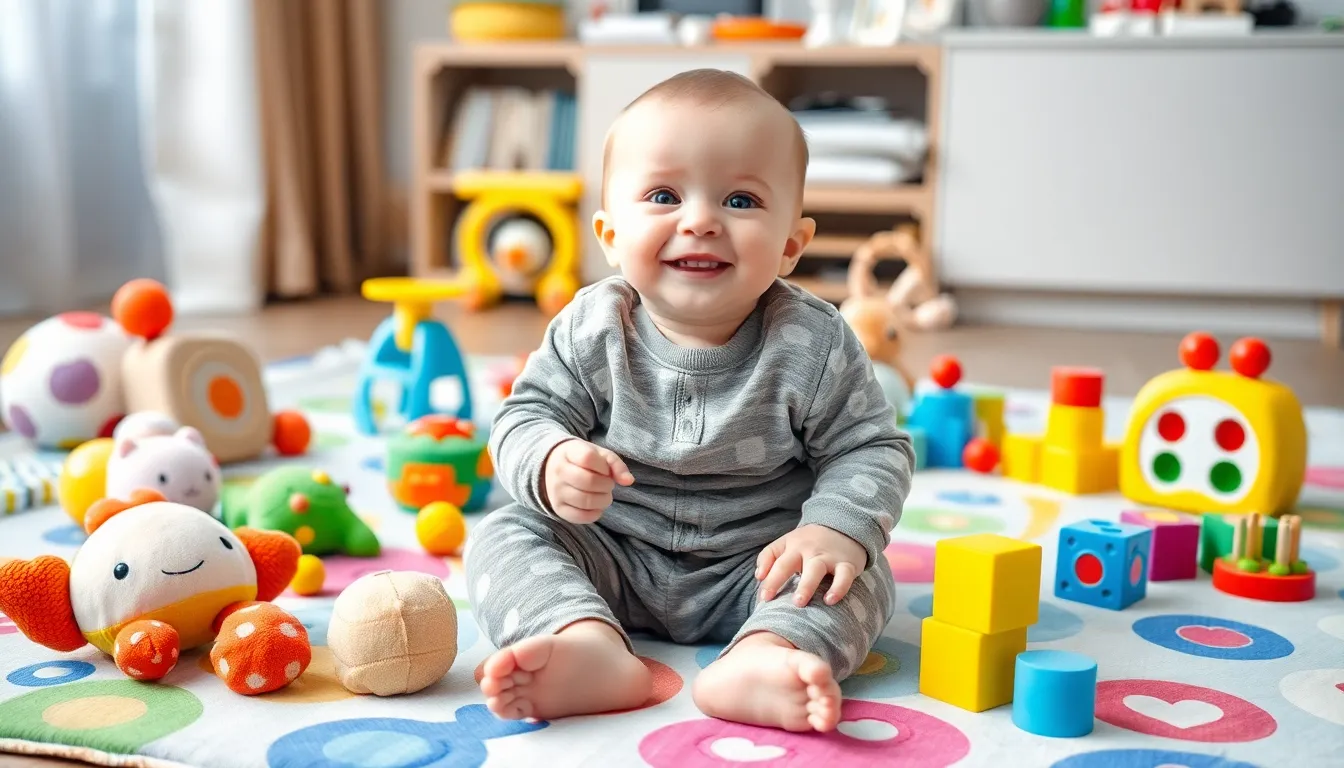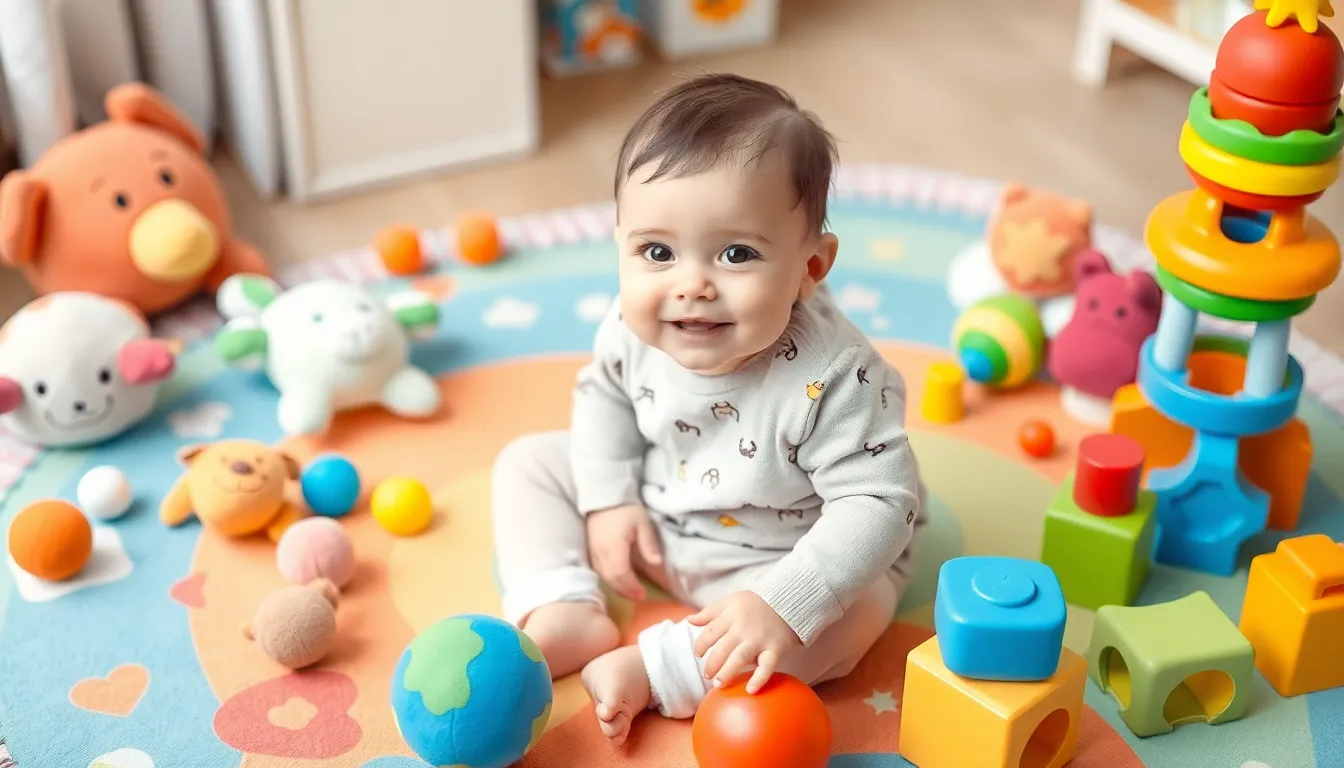Choosing toys for babies aged 6 to 12 months can feel like a daunting task. With so many options out there, it’s easy to get lost in a sea of colorful plastic and catchy jingles. But fear not! This is the golden age of exploration for little ones, and the right toys can turn a simple playtime into a thrilling adventure.
Table of Contents
ToggleImportance Of Play For Babies
Play serves a vital role in the development of babies aged 6 to 12 months. During this period, infants engage in sensory exploration, discovering their surroundings through touch, sound, and sight. Structured toys stimulate cognitive growth while promoting motor skills.
Social interactions occur through play as caregivers interact with babies, fostering bonding and communication. Ensuring that playtime includes a variety of toys enhances a child’s ability to recognize shapes, colors, and textures.
Language skills begin to develop during this stage as caregivers describe activities and objects. It encourages vocabulary expansion and comprehension. Nonverbal cues and gestures also play a crucial role, introducing understanding beyond words.
Fine motor skills get refined through gripping, shaking, and manipulating toys. Each action enhances hand-eye coordination and muscle strength. Gross motor skills benefit from toys that promote crawling, standing, or reaching, supporting physical development.
Cognitive skills improve through problem-solving and cause-and-effect experiences found in play. Toys that respond to actions, like lights or sounds, engage a baby’s curiosity and encourage exploration.
Emotional development occurs as infants express joy, frustration, and excitement. Playtime provides an outlet for these emotions, promoting resilience and social-emotional skills.
Overall, playtime not only entertains but also significantly contributes to healthy development in multiple domains. The right toys enhance these experiences, ensuring that babies flourish during these formative months.
Types Of Toys For Babies 6-12 Months


Selecting the right toys enhances playtime and supports development during this key growth period. Various toy types provide essential benefits for babies aged 6 to 12 months.
Soft Toys And Plushies
Soft toys and plushies comfort babies with their gentle textures and cuddly designs. These toys nurture emotional security and encourage imaginative play. They often feature different fabrics and patterns, stimulating tactile exploration. When babies hug or squeeze plush toys, they develop fine motor skills and hand-eye coordination. Many options also have features such as crinkly sound or rattles that engage the senses. Selecting soft toys with washable materials ensures hygiene and longevity.
Sensory Toys
Sensory toys captivate babies with diverse textures, colors, and sounds. This type of toy supports sensory development by encouraging exploration through touch, sight, and hearing. Common features include bright colors, various shapes, and sounds like rattles or chimes. Babies learn cause and effect while playing with these toys, enhancing cognitive abilities. Options such as textured balls or multi-sensory activity mats promote interaction and stimulate curiosity. Sensory toys play a crucial role in developing awareness of surroundings and improving focus.
Educational Toys
Educational toys introduce babies to foundational concepts in fun ways. This category often includes building blocks, stacking toys, and shape sorters. Engaging with these toys supports cognitive development and problem-solving skills. As babies manipulate different shapes and sizes, they enhance motor skills and hand coordination. Many educational toys also promote language development through simple words or sounds associated with play. Choosing toys that incorporate colors, numbers, or animals fosters early learning and discovery.
Safety Considerations For Baby Toys
Safety is paramount when selecting toys for babies aged 6 to 12 months. Parents should consider multiple factors that ensure their child’s safety during playtime.
Material Safety
Material choice directly impacts toy safety. Non-toxic materials are essential since babies explore with their mouths. Look for toys labeled BPA-free, phthalate-free, and made from safe plastics. Soft, washable fabrics are advisable for plush toys. Avoid toys with small parts, which pose choking hazards. Regularly inspect toys for wear and tear to maintain safety standards.
Size And Age Appropriateness
Size plays a critical role in toy safety. Toys designed for infants between 6 to 12 months should fit their developmental stage. Choose toys that are large enough to prevent choking, typically over 1.25 inches in diameter. Age-appropriate toys stimulate curiosity while minimizing risks. Manufacturers’ age recommendations guide parents in selecting suitable options. Prioritize durable designs to withstand rough play, ensuring longevity and safety.
Popular Toy Recommendations
Wooden blocks stand out for their versatility, encouraging creativity and fine motor skills. These blocks come in various shapes and sizes, enabling infants to stack, sort, and build.
Soft plush animals provide comfort and imaginative play, assisting in developing emotional bonds. Available in different textures and colors, these toys engage infants while promoting sensory exploration.
Sensory balls, with varied textures and sizes, promote tactile engagement. Their lightweight design makes them easy for babies to grasp, roll, and throw, enhancing gross motor skills.
Developmental play mats serve as interactive spaces that stimulate exploration. Equipped with toys, mirrors, and textures, these mats foster visual and motor skill development as infants reach and grasp.
Musical toys capture infants’ attention through sounds and melodies, stimulating auditory development. Options like rattles or small drums encourage movement and coordination during play.
Stacking toys, including rings and cups, enhance problem-solving skills. Babies learn to balance, arrange, and intent during play, which strengthens cognitive abilities.
Shape sorters introduce foundational concepts while enhancing dexterity and hand-eye coordination. Engaging with these toys helps infants understand shapes and spatial relations.
Bath toys transform bath time into a playful experience that promotes sensory exploration. Floating toys and squirters invigorate water play, contributing to social interaction with caregivers.
Interactive books filled with textures and flaps engage infants in early literacy. These books encourage language development and foster a love for reading from a young age.
Selecting appropriate toys based on safety, age recommendations, and developmental benefits ensures a rewarding playtime experience. Prioritizing non-toxic materials and avoiding small parts enhance safety for infants during play.
Selecting the right toys for babies aged 6 to 12 months is essential for their growth and development. Thoughtfully chosen toys not only provide entertainment but also foster important skills like cognitive abilities and motor skills. By prioritizing safety and developmental appropriateness, parents can ensure their little ones enjoy a safe and enriching playtime experience.
As infants explore their surroundings through play, they build connections and enhance their emotional well-being. The right mix of sensory, educational, and imaginative toys can create a stimulating environment that nurtures curiosity and learning. Investing in quality toys designed for this age group supports a solid foundation for future growth and development.




